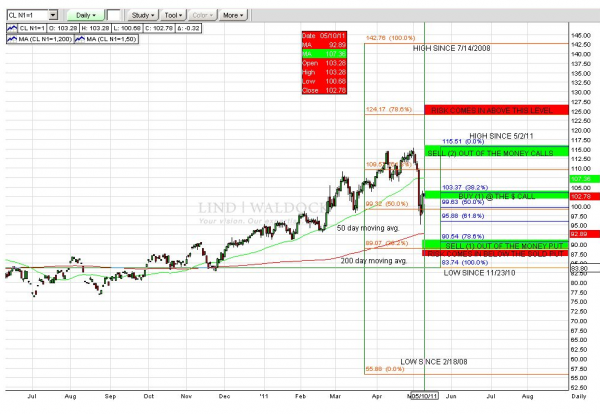Crude oil has been on a rollercoaster ride along with many other commodities in the past few weeks. Considered the “mother of all commodities,” crude impacts many other markets and products we use every day. I think this market was in need of a correction, but that may not mean lower oil prices are here to stay.
During the first week of May, commodities saw sharp declines, and crude oil was no exception, sliding more than17 percent from a peak above $114 a barrel on May 2 to low of under $95 on May 6. The rapidness of this decline was extraordinary.
Some recent fundamental factors affecting oil include inventory data from the Energy Information Administration, renewed European debt worries, and the better-than-expected non-farm payrolls number in the April employment report. While investors might have thought the downturn in crude oil was the start of a larger move lower, some major investment bank research groups were actually increasing their year-end price targets for crude oil. Crude oil closed higher on May 10, 2011 (at $103.88), even after CME Group increased its initial margin for speculative positions to $8,438 from $6,250.
While margin increases can create sharp knee-jerk selloffs as smaller traders can’t afford to stay in their positions, I see the margin increase as just a speed bump. I don’t feel the mid-to-longer-term impact of that factor will be very significant. Growing demand from emerging markets is a larger factor in this market. April trade data just released from China supported the bullish case. Imports were reported at 5.24 million barrels per day, an increase of 1.7 percent versus the same period last year and the third largest net oil imports ever.
Looking at a daily July crude oil chart, I’ve outlined some Fibonacci levels and moving averages I consider when formulating a trading strategy for my clients. I will also outline an options strategy for this market, based on these levels.

When you trade futures, you can be correct about the market’s direction weeks or months from now, but you might not be able to sustain losses and stay in a trade during daily market ups and downs. Options offer individual traders a way to participate in a volatile market such as crude oil, without getting stopped out of a trade. I will outline a strategy that combines buying and selling options, which I feel can help level the playing field for the smaller investor. This strategy is for the purposes of example only and may or may not be suitable for you. I recommend speaking with me directly for more details on a customized strategy for your unique goals and risk tolerance.
Buy one at-the-money 103 call
Sell two 113 calls and one 89 put
The options sold bring in premium to offset the cost of the call purchased. These levels match up perfectly with major support and resistance levels on the chart you see above.
These options expire June 16. Now, this type of strategy is not without risk—it can even be unlimited. If the price of crude oil is above $123 at the time of this option’s expiration date, you would be assigned a short futures position. On the flip side, if the market is trading below $89 at expiration, you would be assigned a long futures position. This strategy does give you some leeway if the market moves up or down through these levels before expiration, but settles somewhere in between. If you think the market will blow past either of these levels in either direction by expiration, you probably wouldn’t want to pursue this type of strategy. However, both of these situations can’t happen simultaneously.
Keep in mind, you don’t have to hold this trade until expiration. You can exit the position if it doesn’t develop the way you might expect. There are also various strategies you can pursue to hedge some of the risk of selling options. I believe the market will trade between $89 and $123 between now and expiration. The “sweet spot” for this trade would be for crude oil to close at $113 at expiration, which would offer me the maximum potential profit.
By setting up these types of strategies, you don’t have to pinpoint an exact target for the market to be successful. At this time of year, we are in transition from winter to summer, (and the summer driving season) which lends itself to volatility—and difficulty picking tops and bottoms.
Longer-term, I see it more likely that crude oil prices will move up, rather than down. Oil is a limited resource that is being depleted. So unless we find some new, safe major source of oil, in my opinion, when we see the types of corrections we saw in early May, prices are not likely to stay down for long.
Tim Merrill s a Senior Market Strategist at Lind-Waldock. He can be reached at 800-326-6266 or via email at tmerrill@lind-waldock.com.
Futures trading involves substantial risk of loss and is not suitable for all investors.
Past performance is not necessarily indicative of future trading results. Trading advice is based on information taken from trade and statistical services and other sources which Lind-Waldock believes are reliable. We do not guarantee that such information is accurate or complete and it should not be relied upon as such. Trading advice reflects our good faith judgment at a specific time and is subject to change without notice. There is no guarantee that the advice we give will result in profitable trades. All trading decisions will be made by the account holder.
Futures Trading, Commodity Futures Brokers. Lind-Waldock, a division of MF Global Inc. 141 W. Jackson Blvd. 1400-A, Chicago, IL 60604
www.lind-waldock.com



